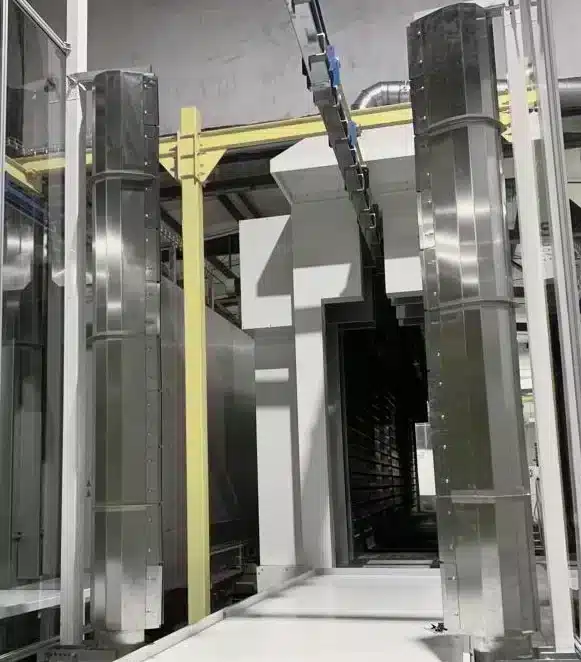Powder coating is a complete industrial process for the treatment of mostly metallic parts. Counts with multiple advantages and it is one of the most extensive surface treatments developed in recent decades. It is a multi-stage process, which is described below.
Stage 1: Pre-treatment
Metal pre-treatment is aimed for preventing corrosion of the surface by means of different washing and drying programmes. As well it is aimed for increasing the adhesion of the paint by treating the surface with e.g. alkaline/acid degreasing, iron phosphate, zinc phosphate or similar.
Therefore, before starting the coating stage, it is important that the surface is thoroughly cleaned of oils and contaminants.
The pre-treatment systems are diverse, they can be spray tunnels, spray booths or pre-treatment by immersion.
All of them with stainless steel structures, top quality insulation and optimised resources. The number of stages and the chemicals to be used for this process depend on the parts and materials treated.


Stage 2: Drying
The drying equipment ensures that the water or fluids from the pre-treatment process are adequately dried and any traces of moisture that could prevent optimum adhesion of the powder coating are removed.
As we know, powder paint bonds to metal metal by electrostatic charge action, and poor drying of the surface, and therefore water or any residue of liquid product -nanotechnology for example- would prevent this physical connection between surface and paint.
The drying oven bases its efficiency on a stream of hot air at an average temperature of between 80 and 100ºC, and it is recommended that it has an adequate volume and speed. In the drying operation, it is very important that the current is homogeneous and continuous, unidirectional and with relative speed in order to drag and eliminate efficiently any trace of humidity or particles in liquid state.
Stage 3: Powder Coating
Powder coating is carried out by electrostatic spraying. During this stage the industrial painting line can have different levels of complexity and automation. The pieces pass through an automatic spray booth and are also coated manually with spray guns to check the details of the process. It is the best way to guarantee the perfect finishing.
Powder is made by a mix of polymer resin combined with pigments and various additives and levelling agents that are converted into a uniform powder. The powder coating application process is known as electrostatic spray deposition. It is carried out with electric and compressed air guns that add the electrostatic charge to the powder particles while applying the paint to the surface. At this stage it is important that the pieces are grounded and electrically conductive, in this case negatively charged, the paint adheres by attraction because it is positively charged


Stage 4: Curing
After the coating stage, it is time for curing. The pieces pass through an industrial oven with a temperature between 180 and 200ºC. The heat application through a chemical reaction produces a high crosslinking density, sticks and fixes the powder coating and guarantees its properties.
The time inside the oven is key in this phase. There are some factors such as thermal inertness and thickness that determine the duration of each process.
Powder coating lines can be tailored to customer needs. A custom design can be made according to the production requirements of your business, ranging from manual processes to full automation of the line.
Do not hesitate to contact our specialists if you want to know more about powder coating or if you need to improve the optimisation of your coating line.



